Learning first aid for toddlers is important for any parent. Toddlers are naturally curious and love to explore, which means bumps, bruises, and minor injuries are a common part of growing up. Knowing how to treat these little mishaps quickly and calmly can make a big difference.
In this article we will look at some common minor injuries in toddlers and the best ways to care for them.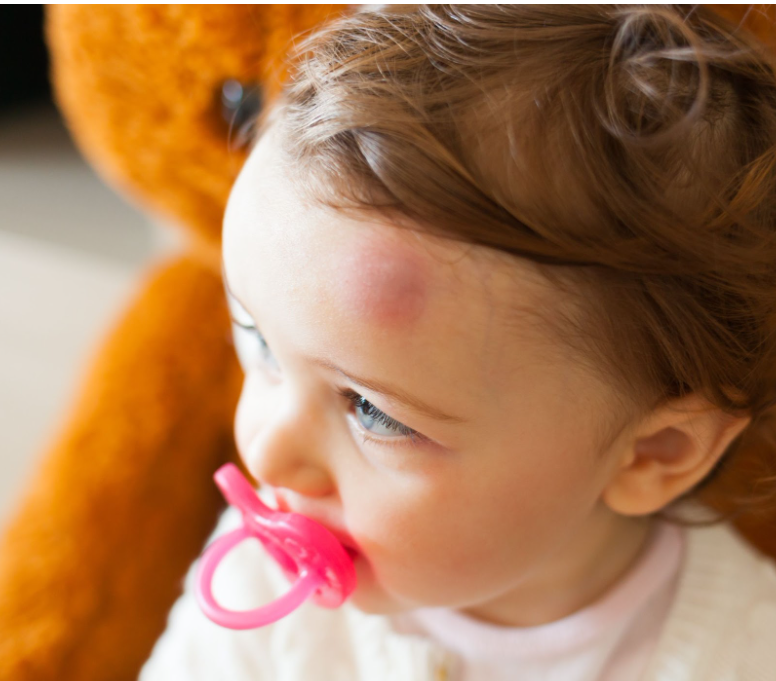
Bumps and Bruises
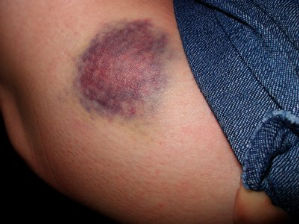 Toddlers, especially adventurous ones, frequently get bumps and bruises, which are very common minor injuries.
Toddlers, especially adventurous ones, frequently get bumps and bruises, which are very common minor injuries.
What to do:
- Bruises are bleeding under the skin.
- Apply a wrapped ice pack for 10 minutes to reduce swelling.
- After that bruises generally take a couple of weeks to disappear.
Head Bumps and Injuries in Toddlers
Toddlers also frequently bang their heads and it is difficult to tell whether or not they have done any serious damage. Most head injuries are not serious and simply result in a bump or bruise. However, severe or repeated head injuries can cause damage to the brain.
Most blows to the head result in injury to the scalp only and this is more frightening than life-threatening as they may bleed profusely. If this happens, don’t panic, get a clean cloth and apply firm pressure to the bleeding area for a good few minutes. Once the bleeding has stopped, you may want to get them checked out, in case the cut needs glueing.
It is very important to look out for anything unusual following a head injury; a severe bang on the head could cause swelling and damage to the brain and it is vitally important that you recognise any early and worrying signs of increased pressure on the brain.
Call 999 or 112 if your toddler:
- Has lost consciousness (even for a moment)
- Won’t stop crying
- Complains of head or neck pain
- Has trouble walking or seems unsteady
For bruised heads and head injuries it is important to look for signs of internal head injury and monitor the casualty closely for the next 48 hours.
Call an ambulance if they have or develop any of the following:
- Unconsciousness
- Obvious serious wound or suspected skull fracture
- Abnormal breathing
- Pupils of unequal size
- Dizziness
- Weakness or paralysis
- Fitting
- Disturbance of speech or vision
- Bleeding or clear fluid from the nose, ear, or mouth
- Neck pain or stiffness
- Vomiting more than once
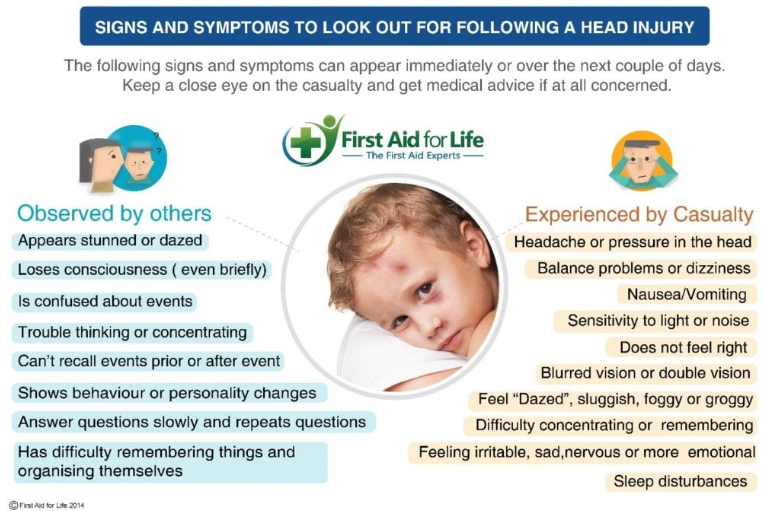
What to do if the child has not lost consciousness and is alert and behaving normally after the fall or blow:
- Apply a wrapped ice pack or instant cold pack to the injured area for 10 minutes.
- Observe your Toddler carefully for the next 48 hours. If you notice any of the signs of brain injury, phone an ambulance immediately.
- If the incident has occurred close to bedtime or nap time and your child falls asleep soon afterward, check in every few hours to look for twitching limbs or disturbances in colour or breathing. It is okay for your child to go to sleep – there is no need to keep a child awake after a head injury – but you do need to remain vigilant. If you are concerned in any way, wake them up to check on them properly.
Grazes and Scrapes
Falling over is a regular part of being a toddler! Scrapes and grazes can be painful but are usually not serious.
Grazes are superficial injuries caused by some of the skin being scraped off, leaving a dirty wound. It is never a priority to clean the wound immediately, usually it can be patched up short term with a plaster and then cleaned properly later once you are somewhere where you can wash your hands, wear gloves and use gauze and water or non-alcohol wipes to clean it thoroughly.
What to do:
- Clean the wound from the inside out and throw away the wipe.
- Repeat this until the wound is completely clean and devoid of any grit or mud.
- Apply a non-adherent dressing pad, shiny side down onto the wound
You can remove the dressing at night to allow the air to get to the wound.
Nosebleeds
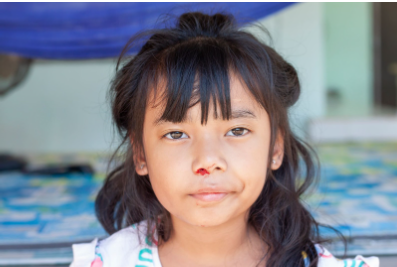
Toddlers often have nose bleeds. They can be a result of warm weather or exercise, which dilate the small blood vessels in their nose, or they can be the result of picking or poking noses, or running into things.
If a toddler has a nose bleed:
- Sit them down.
- Grab something absorbent to catch the blood.
- Lean them forward, pinching the bridge of the nose. Leaning the child forward whilst applying pressure to the nose will allow you to see when the bleeding has stopped and will avoid the blood trickling down the back of their throat which could make them sick. You should apply pressure and try to compress the leaking blood vessel against the inside of the nose to stop it bleeding.
- Keep changing your grip until you have got to a point where no blood is coming out.
- Keep applying pressure for at least 10 minutes.
- Release pressure slightly and if it starts to bleed again hold for another 10 minutes.
- If it really won’t stop bleeding you will need medical help.
Prevent further nosebleeds by:
Advise them not to pick, poke or blow their nose. If it starts again you will have to apply pressure once more.
Special situation
- If the nose bleed has been caused by trauma, or a punch in the face, controlling the bleeding may be difficult but you need to try as loss of blood is dangerous. You should apply a wrapped ice pack, keep applying pressure and get medical help.
More Serious Bleeds
If someone is bleeding the priority is to stop the blood coming out! ALWAYS WEAR GLOVES WHEN DEALING WITH BLEEDING
It is never a priority to wash a major injury – it will be cleaned in the hospital.
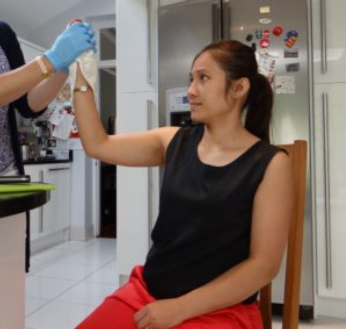
Sit or lie the person down – to manage shock and prevent them from feeling dizzy and faint.
Examine the area to see if there is anything stuck in the wound – if there is do not remove it.
Elevate the bleeding area above the level of the heart to slow down the bleeding. Please note that the latest guidelines no longer specifically include elevation. Elevation alone will not stop bleeding and applying pressure is more important.
Pressure – apply direct pressure on the wound to stop the blood coming out.
Burns and Scalds
The ideal treatment for a burn is to get it under cool, running water as quickly as possible. Treatment should ideally use cool running water of 2-15 degrees in Celsius. You should do this for at least a full 20 minutes. Ice and icy water should not be applied to a burn as this can lead to hypothermia.
Keep the casualty warm and look out for signs of shock.
Remove any loose clothing and jewellery as soon as possible however NEVER remove anything that has stuck to a burn.
If a child is burnt and the area is blistered and larger than a 50p; phone for an ambulance immediately.
Once the burn has been cooled for at least 20 minutes, the burn can be loosely covered with cling film or inserted into a sterile plastic bag if appropriate – alternatively keep running it under water until the paramedic arrives if the burn is very large or on an elderly person or child.
Prepare your First Aid Kit
Having a well-stocked and organised First Aid kit to hand at home will be an invaluable resource for when accidents arise.
First Aid kits need to be easily accessible in case an emergency situation arises. The kit should be well organised, ideally in a bag with compartments to allow you to quickly grab what you need. It is most important that the kit’s contents are good quality – often cheap kits will not be of sufficient quality should you need to use them. The kit should not contain medication.
Your kit should contain a First Aid book or instructions, and contents to treat: major and minor bleeding, burns, breaks and sprains.
About us
First Aid for Life provides award-winning first aid training tailored to your needs – Please visit our site and learn more about our practical and online courses. It is vital to keep your skills current and refreshed.
It is strongly advised that you attend a fully regulated Practical or Online First Aid course to understand what to do in a medical emergency.
To visit our website: https://firstaidforlife.org.uk
or call us on: 0208 675 4036 for more information about our courses.
First Aid for Life is a multi-award-winning, fully regulated first aid training provider. Our trainers are highly experienced medical, health and emergency services professionals who will tailor the training to your needs. Courses for groups or individuals at our venue or yours.
First Aid for life provides this information for guidance and it is not in any way a substitute for medical advice. First Aid for Life is not responsible or liable for any diagnosis made, or actions taken based on this information.



